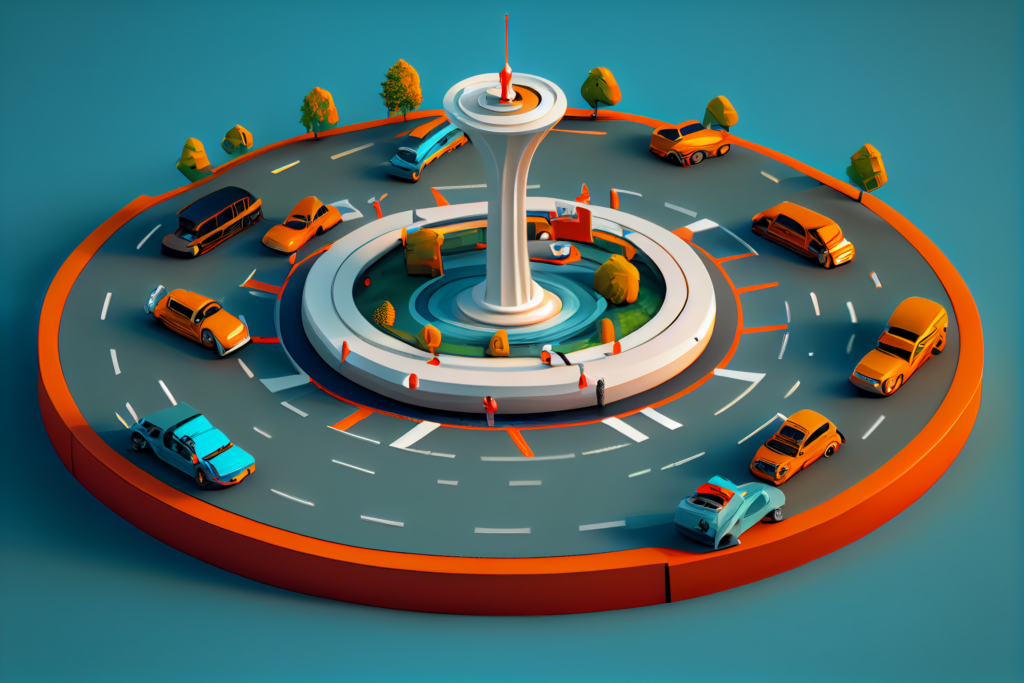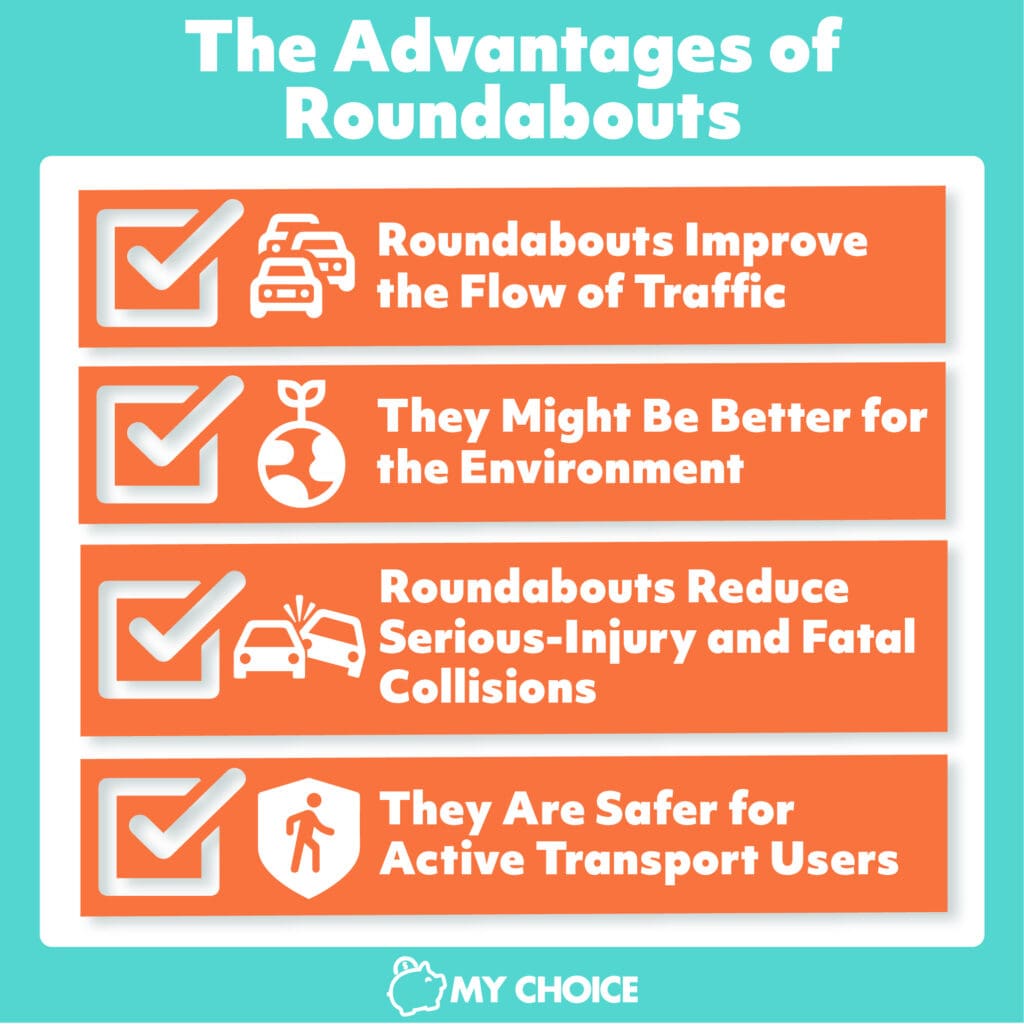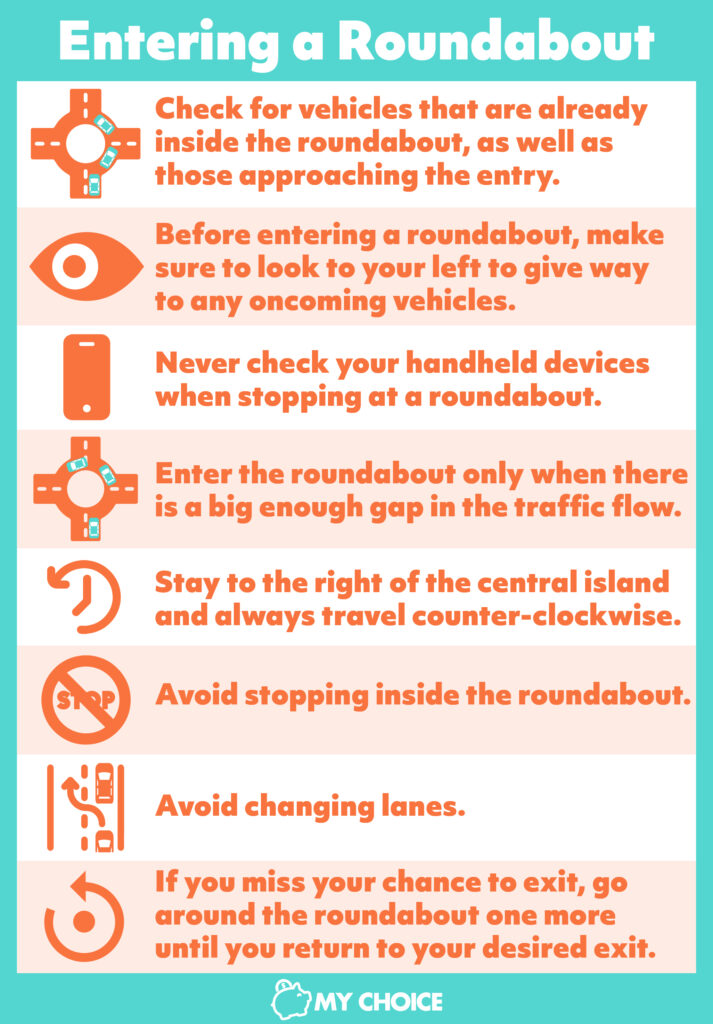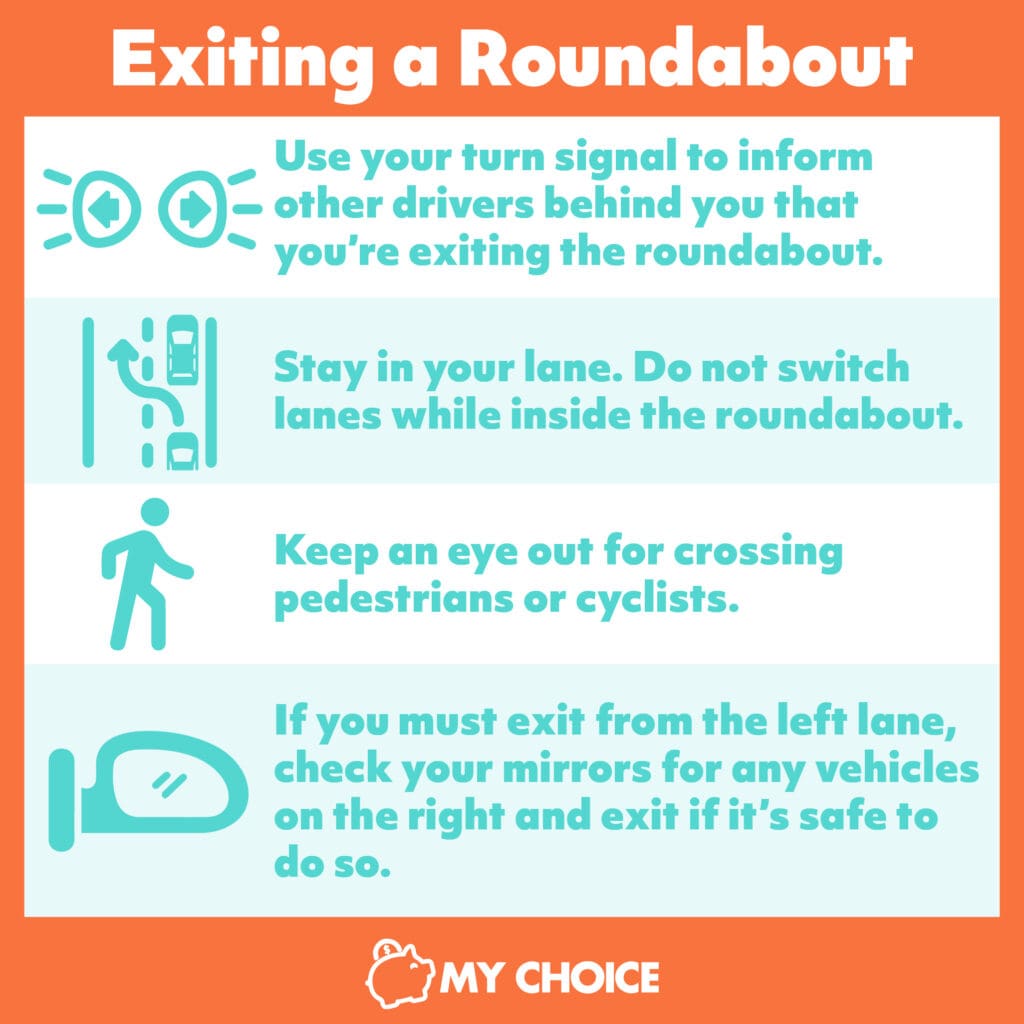
More and more roundabouts have been popping up in Ontario for the past few years. Research shows that roundabouts have a myriad of advantages over traditional intersections, including reducing the percentage of fatal crashes by about 90 percent.
But for motorists who have grown accustomed to the typical four-way stop intersection, rules of a roundabout can seem intimidating at first. For some, supposedly basic rules like who has the right of way, when to use your turn signals, and how to safely pull over for an emergency vehicle may not feel as intuitive as they used to.
Nobody wants to get a ticket for violating a simple traffic rule, but there is no need to worry. Below, we discuss everything you need to know about roundabout rules in Ontario. By the end of this guide, you should have the confidence to drive around a roundabout without breaking a sweat!
What is a Roundabout?
A roundabout is a circular intersection that is designed to promote more efficient and safer traffic flow for drivers, pedestrians, and active transit users.
Modern roundabouts can typically accommodate large vehicles such as buses, trucks, and trailers. They are usually designed with a raised central island that controls the direction of traffic, encourages slower driving speeds, and reduces the chances of serious collisions.
Modern roundabouts were developed in the 1960s and were first adopted by the United Kingdom, Australia, and other Commonwealth nations. Slowly, other European nations began incorporating roundabouts in city planning as well.
In Canada, roundabouts used to be more common on the Queen Elizabeth Way but lost popularity around the mid-70s due to growing concerns about safety. But redesigns with “tighter corners, speed controls, and requirements that vehicles yield to oncoming traffic” have brought a resurgence of roundabouts in the early 2000s.
Today, there are approximately 400 roundabouts across Canada. The region of Waterloo is said to be Ontario’s roundabout capital, boasting a total of 40 roundabouts.
How Do Roundabouts Work?
Roundabouts work by forcing vehicles to travel around a center island counterclockwise. Traffic flows continuously, unlike in a traditional intersection where drivers must stop and wait for traffic lights to signal their turn to move.
The tight radius and raised center island encourage drivers to slow down, reducing the risk of fatal and serious collisions.
Roundabouts vs Traffic Circles
The main differences between roundabouts and traffic circles are their size and the average speed of traffic in these types of intersections.
Traffic circles are often much larger than roundabouts and are designed as four T-intersection exit and entry points situated around a circle. At these intersections, traffic often has to wait for lights to signal their turn to enter the circle. Within the circle, traffic tends to move faster, with speeds of no less than 30 mph.
Roundabouts, on the other hand, are typically smaller with slower-moving traffic. They normally don’t have traffic lights or signal equipment – instead, they use yield signs and splitter islands at the entry points to encourage drivers to slow down. Traffic speeds rarely exceed 25 mph in roundabouts.
The rules of traffic circles also differ from the rules of roundabouts. For example, when exiting a traffic circle, drivers can do so alongside circulating traffic. In a roundabout, exiting drivers must yield to all traffic regardless of the lane they’re on.
The Advantages of Roundabouts
Roundabouts have become increasingly popular over the last few years, and here’s why:
Roundabouts Reduce Serious-Injury and Fatal Collisions
Studies in the US show that intersections with traffic signals or stop signs that were converted into roundabouts had a 72 to 80 percent reduction in injury crashes and a 35 to 47 percent reduction in all types of crashes. In Europe and Australia, studies have shown that intersections converted into roundabouts resulted in 25 to 87 percent reductions in injury crashes.
The reason for this reduction in accidents leading to injury is that roundabouts have fewer conflict points for serious collisions like T-bones or head-on collisions. The Insurance Institute for Highway Safety (IIHS) explains that the “tight circle of a roundabout” also forces drivers to go slower – giving drivers more time to react and making severe crashes less likely to happen.
Another reason why roundabouts are safer is the presence of the central island, which keeps drivers from getting blinded by the headlights of oncoming cars when driving at night.
Accidents don’t just put drivers at risk of serious injury – they can stay on your driving record for years and raise your insurance premiums drastically.
Roundabouts Improve the Flow of Traffic
Roundabouts don’t just improve traffic safety, they can also prevent congestion and delays.
A study conducted in Nevada, Maryland, and Kansas showed that when stop signs were replaced with roundabouts, vehicle delays went down by 13 to 23 percent.
Another study in Washington, New York, and New Hampshire showed that, in places where roundabouts replaced traffic lights, there was an 89 percent reduction in delays and a 56 percent reduction in stops.
Roundabouts Are Potentially Better for the Environment
With fewer delays and stops, vehicles spend less time idling and emitting greenhouse gasses into the environment.
One study showed that replacing traffic signals or stop signs with roundabouts slashed carbon monoxide emissions by up to 45 percent. It also reduced the amount of fuel consumed by up to 34 percent.
Roundabouts Are Safer for Active Transport Users
Roundabouts are better for pedestrian and cyclist safety than standard intersections. Roundabouts force pedestrians to walk around the perimeter of the circle rather and thus reduce the distance they have to cross. Pedestrians also only cross one-directional traffic rather than having to look out for traffic coming from both sides.

How to Drive Through a Roundabout
When driving through a roundabout, there are some important rules to keep in mind. Here’s what you should know when approaching, entering, exiting, pulling over, and driving a large vehicle in a roundabout in Ontario:
Approaching a Roundabout
When approaching a roundabout, slow down, look out for crossing pedestrians, and keep your eyes open for signage indicating where to exit. If you’re turning left or going straight, use the left lane. If you’re turning right or exiting in the next exit, stick to the right lane.
Remember: You shouldn’t change lanes inside a roundabout. So, if you plan on making a left turn, make sure not to enter from the right lane.
Cyclists can either choose to stay in the centre of the correct lane or dismount and walk along the perimeter of the roundabout like a pedestrian.
Entering a Roundabout
When entering a roundabout, follow these simple tips:
- Check for vehicles that are already inside the roundabout, as well as those approaching the entry.
- Before entering a roundabout, make sure to look to your left to give way to any oncoming vehicles. Vehicles inside the roundabout have the right-of-way – always yield to them before entering.
- Never check your handheld devices when stopping at a roundabout entrance – this counts as a distracted driving offence.
- Enter the roundabout only when there is a big enough gap in the traffic flow. Avoid entering right beside another vehicle as they may be on their way toward the next exit.
- Stay to the right of the central island and always travel counter-clockwise. Traffic flows only in one direction in a roundabout.
- Avoid stopping inside the roundabout to avoid accidents.
- Avoid changing lanes inside the roundabout.
- If you miss your chance to exit, go around the roundabout one more until you return to your desired exit.

Exiting a Roundabout
When exiting a roundabout, make sure to:
- Use your turn signal to inform other drivers behind you that you’re exiting the roundabout. Try to do this upon passing the exit right before your chosen exit.
- Keep an eye out for crossing pedestrians or cyclists.
- Stay in your lane. Do not switch lanes while inside the roundabout.
- If you must exit from the left lane, check your mirrors for any vehicles on the right and only exit if it is safe to do so.

Pulling Over for Emergency Vehicles in a Roundabout
Sometimes, you’ll find yourself in a roundabout while an emergency exit rushes through. To properly pull over your car to let the emergency vehicle through, exit at your desired exit and drive past the next traffic island before you pull over.
If you’re waiting to enter a roundabout, pull over to the right and wait for the emergency vehicle to pass you.
Driving Large Vehicles in a Roundabout
If you’re driving a truck, bus, RV, or any other type of large vehicle, you are allowed to occupy both lanes of the roundabout to enter, especially if it’s a tight turn.
Once inside, you can use the full width of the intersection, as well as the apron or the mountable part of the centre island. Take note that driving over the island is illegal.
If you’re driving behind or next to a large vehicle, make sure to yield to them and avoid passing them. They need space to manoeuvre safely.
Common Roundabout Signs to Look Out For
Here’s how to decipher common road signs you’re likely to find in or before the entrance to a roundabout:
- Roundabout approaching: A yellow sign featuring three black arrows going around in a circle. This indicates that a roundabout is up ahead. Drivers must slow down upon passing this sign.
- Yield: A red and white upside-down triangle. This sign signifies that drivers should yield the right-of-way. If necessary, drivers must stop for any oncoming traffic before entering the roundabout.
- Directional signs: Green and white road signs featuring the street names for each exit. These guide drivers to their desired exits.
- Exit signs: These signs appear a few meters ahead of exits, signifying the names of the street or town the exit leads to.
- Lane markings: Side-mounted or overhead signs that tell drivers which lane they should position themselves on the roundabout so they can leave at the correct exit.
- Traffic direction: A horizontal sign featuring yellow and black arrows pointing to the direction that traffic flows in the roundabout.
- Speed limit: The maximum speed limit you should follow while driving in the roundabout.
- Median or island ahead: This notifies drivers of obstructions like islands or medians coming ahead.
- Truck encroachment: This tells drivers that large vehicles such as trucks and buses are allowed to use both lanes in the roundabout.
Frequently Asked Questions About Roundabouts in Ontario
Who has the right-of-way in a roundabout?
Drivers who are already inside the roundabout get the right of way. Vehicles approaching the roundabout yield their right-of-way to traffic inside the roundabout and must wait for a safe opportunity to enter.
Can cyclists use roundabouts?
Cyclists can use roundabouts. If you wish to ride inside the roundabout, make sure to stay in the centre lane so you are visible to other motorists. When exiting, use your hand signals to let drivers behind you know they should slow down.
If you don’t feel safe or confident enough to cycle through a roundabout, dismount at the entrance and walk your bike across the pedestrian lane.
Should you use your turn signals in a roundabout?
Always use your turn signals when turning right and approaching your intended exit at a roundabout.
How many times are you allowed to drive around a roundabout?
If you miss your exit, just drive around the roundabout until you get back to your intended exit. However, be wary of driving continuously around the roundabout more than twice. This can earn you a traffic ticket for careless driving.
If you don’t know which exit to take, just take the closest one and pull over to figure out where you need to go next.
What lane should I use in a roundabout?
To decide which lane to use in a roundabout, you have to know where you’re exiting.
If you’d like to take the first exit, enter from the right lane, keep your signal light on, and drive through the outer lane and into the first exit.
If you must drive straight through the roundabout, you can take either the left or right lane. Make sure to exit directly from your chosen lane when you arrive at your desired exit.
If you are making a left turn or exiting at the last exit, take the left lane. Drive on the inner lane until you reach your exit and make your left straight from the inner lane.
Key Takeaways
To avoid collisions, always follow the rules of a roundabout – particularly, yielding the right-of-way when entering the roundabout and avoiding switching lanes while inside. Be sure to familiarize yourself with common road signs associated with roundabouts as well.
Keep yourself and your fellow drivers safer by following this simple guide to driving in Ontario roundabouts!








